Football

About Football
Football or Soccer is one of the oldest and the most loved sports. The simplicity of rules and mass appeal makes it popular globally. Two players and a football are required to start a simple game. This sport is played by men and women as a separate team event.
Different football tournaments and Championships are organized across the world that invites players having different skills and capabilities. Premier leagues of many European countries, Copa America, Euro Championships, World cup, and Olympics are some of the tournaments organized around the world.
It is a team sport played on an outdoor field that demands endurance, skill, and stamina from the players. Fédération Internationale de Football Association (FIFA) is the governing body responsible for organizing tournaments and deciding the rules for the sport.
FIFA is headquartered in Zurich, Switzerland, and comprises 211 member nations. Russia was suspended from its membership after it invaded Ukraine. The objective of FIFA involves the promotion of football, making it accessible across nations, advocating integrity and fair play, and hosting tournaments.
Football Olympic 2020 logo : ![]()
History
The early history of football traces back to the 3rd Century BC in China. This became a popular sport in the courts of the Japanese emperor in 600 AD. There are records that Roman and Turkic people also played this sport.
English public schools first codified the rules of the sport, and it was a popular sport among different schools. Football clubs started sprouting up during the middle of the 18th century, and football started gaining popularity.
Football was introduced as a part of the Olympic Games in 1900 in Paris, and women’s football was introduced in 1996 at Atlanta Olympic Games. Since then, this sport has been part of every Olympic Games.
Objective
The objective of Football is to score more goals than your opponent in the stipulated time. The team scoring the maximum number of goals wins the game.
The duration of the game is 90 minutes, and divided into two halves, each of 45 minutes duration, plus additional time added by the referee due to injury stoppages. A 15 minutes break to divide, the first half from the second half.
If a game ends up in a tie, two 15 min extra time are allocated to the teams. A penalty shootout determines the winner of the match wherever a result is desired, in case of a tie after the extra time.
Football Field
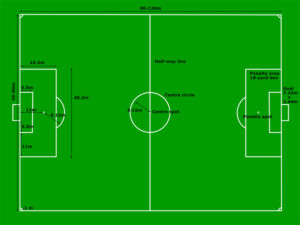
The field where football is played is called the football field. This can be a natural turf playing surface or artificial turf. This is a rectangular field; the longer side is known as the touchline, while the shorter side is called the goal line.
The longer side of the football field measures 120 m, while the shorter side measures 90 m. A runoff area of 3m surrounds the football pitch, devoid of any fixed obstacles or objects to prevent injury to players.
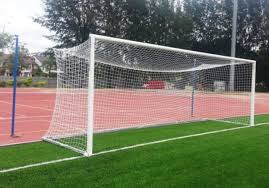
Goal Posts: Two-goal posts on either side of the shorter side are erected, having a length of 7.32 m and an elevation of 2.44 m. A spot from where the player takes penalty shots is placed 11 m from the center of the goal-line known as the penalty spot.
Each goal post has a rectangular D section surrounding the post, each having length of 40.3 m and a width of 16.5 m. The goalkeeper is allowed to touch the ball with their hands within the marked D section. Touching the ball with a hand outside the D by the goalkeeper invokes a foul.
A smaller rectangular D is marked within the larger D section having a length of 29.3 and breadth of 5.5 m, and used for taking goal kicks by a player or goalkeepers. A half line divides the field into two halves, each half houses a team.
The central point of the half line is called the center point, having a circle with a radius of 9.15 m. The center point is used to start the game. The goal line is the line joining the goal posts, and the ball should cross the goal line completely to be counted as a goal.
Nets made of strong quality nylon fiber are installed on both the goal posts for stopping the ball that goes inside the goal. They are installed to have a fair idea that the ball has indeed been put inside the goal, and for protecting the spectators sitting beside the goal posts.
Follow FIFA World Cup 2020
Football Players
- Each team comprises 11 players, one of them being the goalkeeper and the remaining 10 are outfielders. The goalkeeper is allowed to wear gloves, and they can touch the ball with their hand within D of their half.
- The game involves different strategies and has become highly technical in terms of approach and team setting. Coaches select the players for a match based on the requirements, and they also plan the playing positions of the players. Commonly used playing positions are:
- Goalkeeper: The only player in the team that can touch the ball with hands within the 18 yards D section within their goalpost. Their main objective is to prevent the ball from going inside their goal post. They should have good reflexes and dominate the aerial area around the goal post.
- Forwards: They search for an opportunity to score a goal, they are the most agile players, and create chances for the team member at the most suitable position to score a goal. Centre forward, also called strikers are the leading scorers of the side, and they are the most tactical and skillful players and always look out for the smallest of opportunities to score a goal. They should possess off-the-ball intelligence and accurate heading abilities.
- Midfielders: They serve as a link between the defenders and the forward line. They are strong, and they are the ones to do the maximum running during the match. While attacking they should remain close to the forwards while during defending they need to fall back and help the defenders. They should have great stamina and excellent ball passing abilities.
- Defenders: They are strongly built players having the ability to thwart the attack imposed by the opponent team. They help in taking possession of the ball from the attacking players preventing them to enter the goal area.
- Wingers: They cover up the extreme right and left ends of the football fields. They have excellent pace and dribbling skills to run with the ball with close control.
How The Game Is Played
- At the beginning of the game, the referee calls both the team captains and tosses a coin. The winner of the toss can either select to start the kickoff or select their half.
- The game starts with the first kick by a team member of the toss-winning team; the timer for the match also starts from this point.
- If the ball goes out of the playing area from the length of the field, a throw-in results, where a player of the opposing team that kicked the ball out, is allowed to throw in the ball with both hands, and both feet touching the surface during the throw-in. Else it results in a false throw, and the ball passes to the other team for a throw-in from the same point.
- If the ball goes out of the playing area from the breadth (shorter) side by the attacking team, goals kick results. But if a team member of the defending team has touched the ball out, the attacking team gets a corner kick.
- After the time for the first half has elapsed, that round to 45 min plus extra time added by the referee, the second half begins with the first kick by the team losing the toss. The teams also change their halves. So a team playing left to right in the first half plays from right to left in the second half.
- The game ends after the stipulated time of 90 min plus the added time provided by the match referee, and the team scoring the maximum number of goals during that period is considered the winner.
- In case of a draw, the points are divided equally between the teams. In competitions where the winner is required, a provision of extra time is allocated to the teams.
- Extra time comprises 30 min duration plus the added extra time by the referee. The extra time is also played in two sessions of 15 min each with a brief 5 min break in the middle. The total goal scored by the team in the stipulated time plus the extra time is counted as the total goal scored. The team scoring the maximum number of goals wins the match.
- In case of a draw after the extra time, a penalty shootout is organized by the referee. For a penalty shootout as well a fresh toss of the coin is done by the referee and the two captains for deciding the team starting the kickoff and on the side of the football field where this shootout is organized.
- In a penalty shootout, each team is allocated 5 shots to be taken by five different players playing after the completion of extra time. The ball is placed at the penalty spot by the player taking the shot, with only the goalkeeper defending the shot from entering the goal.
- The player is only allowed to kick the ball once during the penalty shootout, no other player other than the opponent team's goalkeeper can touch the ball.
- Sudden Death: In case the five allocated penalty kicks fail to produce a winner, the rule of sudden death is implemented. Each team is allocated one shot; the team scoring wins the match if the opposing team fails to score in their allocated kick.
- In case of a draw situation in sudden death, the allocation of a single kick continues unless a clear winner emerges.
- When a goal is scored, the game re-starts from the center point by a player of the scored team.
Football Equipments
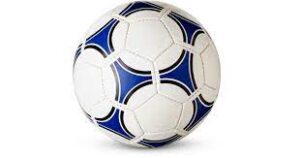
Football: The football is spherical, and has a 22 cm diameter comprising of latex or butyl rubber bladder that makes the football pressurized. A ball of size 5 is used for playing, and the weight of the ball is between 410 to 450 gm.

Goal Post: They are made of hollow iron pipes painted at the top to make them strong. Two-goal posts are present at the two ends facing each other.
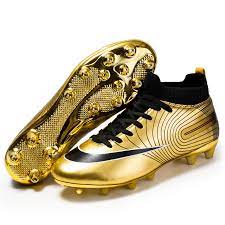
Shoes: A must for every football player as the sport involves a lot of running. They are specially designed shoes having spike that provides a better grip to the players running on grass.
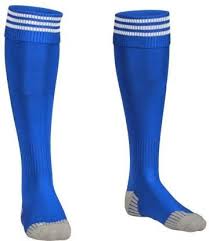
Socks: The shoes work with socks. The socks are long almost to the knee as they also cover the shin guards.
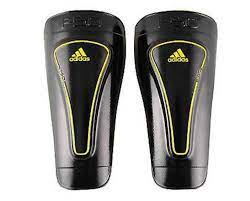
Shin Guards: This protective equipment is mandatory, and helps in protecting the player’s shin area. Players indulge in tackles both intentionally and unintentionally.

Net: Net made out of strong polyester fiber with the ability to withstand strong force, are used to cover the back of the goal posts.
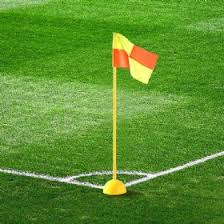
Flag Posts: Four flag posts indicating the four corners of the football field are used for identifying the corners. Made from a plastic hollow rod, so that it does not injure any player hitting the post.
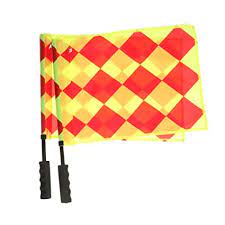
Referee Flags: They are flags carried by assitant referees. These flags are used to gather attention of the main referee and inform about the foul commited. Different flag signals are used to denote the type of fouls.
Football Officials
The match officials governing the match are referred to as referees. They are appointed by FIFA for international matches and tournaments. The match officials include a referee, an additional referee, two assistant referees, two additional assistant referees, one video assistant referee, and one assistant video assistant referee.
Referee: The conductor of the match, the referee is responsible for all the on-field decisions. The referee takes the final decision. Though the referee has the entire ground to run they run following a diagonal path.
Assitant Referees: The assistant referee assists the main referee. They are posted on the diagonal sideline with a flag and assist the referee with the throw-in of the ball, they also check for different fouls committed by players in their half and inform the referee. They also assist the referee with the offside violation by a player of the opponent team. The area of the assistant referee is from the half line to the goal line on the diagonal side of the football pitch.
VAR: Video assists referee is used to assist the referee with the goal line decisions or any other decisions that the referee may ask for their assistance.
Doctor: On-field medical staffs are always present in case of any emergency. Every team has its own team doctor that assists players with nominal injuries.
Terms Associated With Football
- Dribble: To get pass an opponent player skilfully without losing possession of the football.
- Cross: A pass played by a player at the face of the goal.
- Free Kick: A kick to the ball awarded by the referee against a foul committed by an opposing team player.
- Corner Kick: A free kick taken by a player of the opponent team from any corner of the team guilty of moving the ball out of the goal sideline.
- Dummy Run: A run initiated by a player without the ball to lure the opponent team player that the attack will be happening from this direction.
- Goal Kick: A kick offered to the defending team when the ball goes out of the goal line by a member of the attacking team.
- Man to Man Marking: A defensive position where a player is assigned to guard against a player of the attacking team.
- One touch: A pass where the player passes on the ball with one touch.
- Sliding tackle: A tackle where a defender slides towards the attacking team member before making contact with the ball.
- Sweeper: A defensive player that is the last line of defence before the goalkeeper and is positioned behind the defenders.
- Volley: Kicking the ball in the air before the ball drops to the ground.
- Tackle: To take the ball away from the opponent using fair means.
- Obstruction: A player obstructing by blocking another player physically.
- Bending the ball: Taking a kick at the ball such that the ball curves in its trajectory.
- Backflip: A stance taken by the player where the player does a backflip and hits the ball over his head.
- Indirect free kick: A kick taken by a player through which a goal cannot be awarded unless it has not touched any other player.
- Through Pass: A pass given by a player in free and vacant space, with the knowledge that a player from his team is going to reach the ball first.
- Dead ball: When the ball is not moving and the play has been stopped due to either some injury to a player.
- Own Goal: A situation where the player unintentionally kicks the ball into their own goal resulting in a self-goal.
Fouls in Football
The referee keeps a sharp eye on each pass and the way the game is played. Any violation or unwanted tackle from any of the players results in a foul. Rewards are awarded by the referee against the offender team in case of a committed foul.
The rewards are in the form of a direct free kick or indirect free kick. A direct free kick is awarded for a foul committed around the penalty corner. An indirect free kick is awarded when a player impedes the progress of another player.
Penalties are awarded by the referee for any foul or a deliberate handball or unethically stopping the progress of an attacking team member.
Referees can punish a player found to violate the rules of the game. Any unwanted tackle or deliberate act of any mischief results in a warning issued by the referee by displaying a yellow card.
Two such warnings to the same player result in displaying a red card resulting in the eviction of the player from the match.
A foul that is considered a dangerous play or deliberate act of maligning the game invites a direct red card from the referee that evicts the player from the match.
Offside Rule in Football
When a player having the ball is in a position nearer to the goal with no other defending team player is between the ball and the goal the player is ruled as offside. This offside rule, however does not apply when an attacking player is on their half and starts running towards the goal by overtaking all the defenders.
When the referee decides an offside then the defending team is awarded an indirect free kick. No team member is penalized for this situation.
Substitutions in Football
A maximum of five players can be available for substitution, and one of them is the goalkeeper as this is a specialized position. The list of players that can come over as substitutions should be handed over to the referee.
A team is allowed to have three substitution opportunities. If any team has not utilized all the three available substitutions and the game goes into extra time, then the team can use their substitution during the extra time.
The substitutions can be made any time during the playing duration and during halftime. The player leaving the field can leave the field entirely before the substitute can enter the field.
During the play substitution only occurs when the play is stopped due to some injury or the ball going out of play and not when the ball is in play.
Rules Of Sport
- The players are not allowed to wear sharp objects that can harm other players or cause an injury.
- Only goalkeepers are allowed to wear gloves for protecting their hands.
- Outfield players are not allowed to touch the ball with any hand.
- Ejected team members or officials should leave the arena immediately and should not have contact with the team.
- The game is played in two halves of 45 min duration with a 15 min break.
- Play can be stopped by a referee or player just hitting the ball out anytime due to an injury.
- The players should respect the spirit of the game and uphold the same. They should not involve in any activity dampening the spirit of the game.
- The team scoring the maximum number of goals within the allocated time wins the match.
- The ball should entirely cross the goal line to be considered a valid goal.
- After scoring a goal, the game starts from the centre point, with a player of the team consuming the goal starts the game by taking the first kick.
World Rankings
- Mens Football Rankings
- Brazil

- Belgium

- Argentina

- Womens Handball Rankings
- USA

- Sweden

- Germany





 (1 votes, average: 5.00 out of 5)
(1 votes, average: 5.00 out of 5)


